Boot the Router
Use the console port on the Route Processor (RP) to connect to a new router. The console port connect to the XR console by default. If necessary, subsequent connections can be established through the management port, after it is configured.
Procedure
|
Step 1 |
Connect a terminal to the console port of the RP. |
||||
|
Step 2 |
Start the terminal emulation program on your workstation.
The baud rate is set by default and cannot be changed. |
||||
|
Step 3 |
Power on the router. Connect the power cord to the power module. Turn on the router by switching the power switch to the "ON" position. The power switch is usually located near the power module. The router boots up. The boot process details are displayed on the console screen of the terminal emulation program. |
||||
|
Step 4 |
Press Enter. The boot process is complete when the system prompts to enter the root-system username. If the prompt does not appear, wait for a while to give the router more time to complete the initial boot procedure, then press Enter.
|
What to do next
Specify the root username and password. For more information, see Setup Root User Credentials.


 Feedback
Feedback